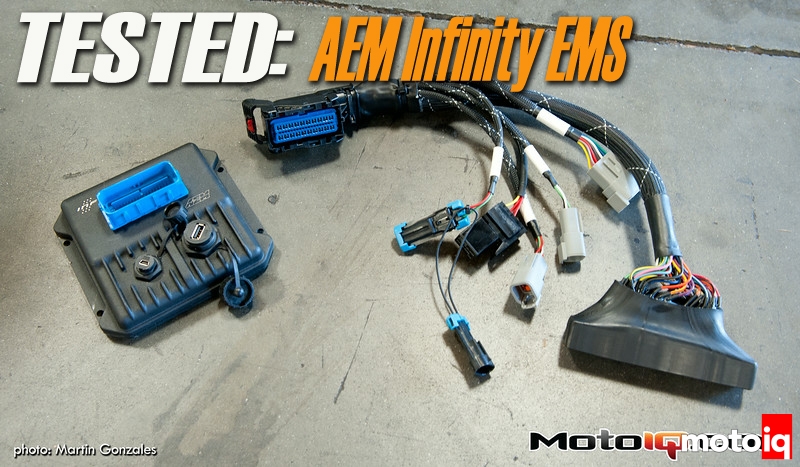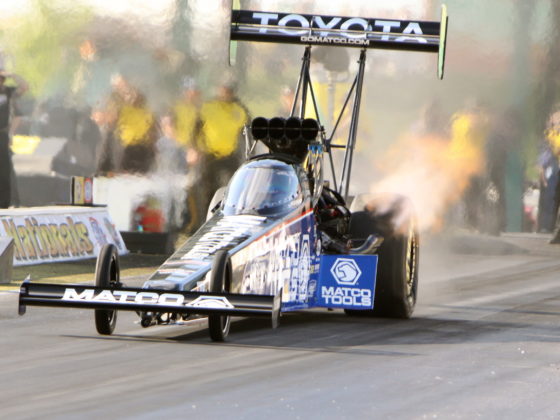,
 With our parameters set it was time to do some dyno pulls to see how close we were. With the AEM Infinity it is remarkable how fast the tuning session can go.
With our parameters set it was time to do some dyno pulls to see how close we were. With the AEM Infinity it is remarkable how fast the tuning session can go. With just a few pulls the tuning was set and we were ready to configure the engine protection parameters, another easy to do function within the AEM Infinity EMS.
With just a few pulls the tuning was set and we were ready to configure the engine protection parameters, another easy to do function within the AEM Infinity EMS.  The first parameter to set is knock protection. We were impressed by how sophisticated and easy to use the AEM Infinity EMS was. With advanced processing the Infinity can detect and measure knock by individual cylinder when using only one knock sensor. That's some fancy maths! First you calculate your cylinder center frequency with a simple algebraic equation and enter it. The amplifier gain is your knock noise limit or the pink trace you see on the bottom graph. The lower you set it, the lower the ceiling before the EMS takes action. It is good to be able to adjust this because engines often make noises other than knocking and it is good to be able to take control of it fully yourself as a tuner. The individual cylinder noise traces are the colored squiggly lines below the pink one. The integrator time is a smoothing function, This is so the EMS won't over react to very slight noise peaks which could be harmless overtones or harmonics of existing noise. 300 us is a good place to start but if your engine has natural ringing or other noise issues you can adjust it. Taking care of detonation is also cool, the timing is retarded, the mixture is enriched or both. The operational window of detonation control, the onset and decay of the adjustment event can all be adjusted discreetly. This can be done either globally or by individual cylinder. How cool is that?!
The first parameter to set is knock protection. We were impressed by how sophisticated and easy to use the AEM Infinity EMS was. With advanced processing the Infinity can detect and measure knock by individual cylinder when using only one knock sensor. That's some fancy maths! First you calculate your cylinder center frequency with a simple algebraic equation and enter it. The amplifier gain is your knock noise limit or the pink trace you see on the bottom graph. The lower you set it, the lower the ceiling before the EMS takes action. It is good to be able to adjust this because engines often make noises other than knocking and it is good to be able to take control of it fully yourself as a tuner. The individual cylinder noise traces are the colored squiggly lines below the pink one. The integrator time is a smoothing function, This is so the EMS won't over react to very slight noise peaks which could be harmless overtones or harmonics of existing noise. 300 us is a good place to start but if your engine has natural ringing or other noise issues you can adjust it. Taking care of detonation is also cool, the timing is retarded, the mixture is enriched or both. The operational window of detonation control, the onset and decay of the adjustment event can all be adjusted discreetly. This can be done either globally or by individual cylinder. How cool is that?! Other engine protection limits can easily be added and tweaked. Rev limit via coolant temp, overboost protection, lean mixture and low oil pressure engine shut down can all be applied and two dimensionally mapped. Super easy and super cool. There are no excuses for total engine destruction anymore.
Other engine protection limits can easily be added and tweaked. Rev limit via coolant temp, overboost protection, lean mixture and low oil pressure engine shut down can all be applied and two dimensionally mapped. Super easy and super cool. There are no excuses for total engine destruction anymore. After a very short tuning session we were able to get these results. Big gains in power below 3500 rpm and decent gains above 7400 rpm. The most impressive gains were in the mid range. If the overall power levels look low, AEM's load based Mustang dyno is very stingy and reads 15 to 20 percent less than a Dynojet. Perhaps the best thing was that the total time from removing the stock EMS to recording this pull was around an hour! The car will also benefit from traction control and multi maps for other fuel.
After a very short tuning session we were able to get these results. Big gains in power below 3500 rpm and decent gains above 7400 rpm. The most impressive gains were in the mid range. If the overall power levels look low, AEM's load based Mustang dyno is very stingy and reads 15 to 20 percent less than a Dynojet. Perhaps the best thing was that the total time from removing the stock EMS to recording this pull was around an hour! The car will also benefit from traction control and multi maps for other fuel.
So far we have shown just how easy it is to set up, tune and extract power using the AEM Infinity. We are impressed with the Infinity's flexibility and easy to use engine protection features. More is still to come, as we speak, Tony is upgrading his ride with a built engine and a turbo system.
Once this is done, we will revisit the car and report on the ease of tuning for the turbo, new engine and bigger injectors. Stay tuned!
Sources




2 comments
Hey, I just came across this article while trying to setup my own Infinity on my S2000. How are you switching maps with VTEC activation? The user manual for the infinity is kind of vague on that point. I see you have separate VE tables. Do you also have separate lambda maps and ignition maps? Thanks for any input and guidance you may have.
do you guys had any trouble for temp on oem dash not working?